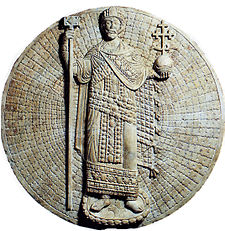Battle of Haram
| Battle of Haram | |||||||
|---|---|---|---|---|---|---|---|
| Part of Byzantine–Hungarian War (1127–29) | |||||||
 Emperor John II Komnenos (r. 1118–1143), commander of the Byzantine forces in the battle. |
|||||||
|
|||||||
| Belligerents | |||||||
| Byzantine Empire |
Kingdom of Hungary Grand Principality of Serbia |
||||||
| Commanders and leaders | |||||||
| John II Komnenos | Setephel | ||||||
| Strength | |||||||
| Unknown | Unknown | ||||||
| Casualties and losses | |||||||
| Unknown | Unknown, possibly heavy | ||||||
The Battle of Haram or Chramon (modern Nova Palanka) was fought between the forces of King Stephen II (r. 1116–1131) of Hungary and Emperor John II Komnenos (r. 1118–1143) of the Byzantine Empire in the year 1128, or possibly earlier – in 1125 (the chronology is uncertain), in what is now Serbia, and resulted in a major defeat for the Hungarians.
John II was married to the Hungarian princess Piroska, and this involved him in the dynastic struggles of the Kingdom of Hungary. In giving asylum to Álmos, a blinded claimant to the Hungarian throne, John aroused the suspicions of King Stephen II of Hungary. John refused a demand from Stephen that Álmos be surrendered to him. The Hungarians, led by the king, then crossed the Danube frontier and invaded Byzantium's Balkan provinces. Most authorities place this event in 1127, with hostilities lasting until 1129; however, an alternative chronology has been suggested with the Hungarian attack and Byzantine retaliation taking place in 1125 with a renewal of hostilities in 1126. The Hungarians attacked Belgrade, Niš, and Sofia; John, who was near Philippopolis in Thrace, counterattacked, supported by a naval flotilla operating on the River Danube.
After a challenging campaign, the details of which are obscure, John II managed to defeat the Hungarians and their Serbian allies at the fortress of Haram or Chramon, located in modern Nova Palanka, on the Hungarian bank of the Danube. The Hungarian army, under a commander named Setephel as King Stephen was ill, had entrenched itself, defending the line of the Danube. The Byzantine historian John Cinnamus describes John II employing a ruse to allow his army to cross the river. He sent a mercenary force composed of "Ligurian knights" (Lombards) and Turks (probably horse archers) to threaten a crossing upstream, while he stayed on the shore opposite Haram with the rest of his army. The ruse worked as his army crossed the river at Haram by boat, the emperor himself on board the imperial trireme. An opposed river crossing is one of the most demanding of military operations. The Byzantine army must have been very disciplined and well supported by archers and bolt-firing artillery on the imperial ships. Once on the Hungarian bank of the Danube the Byzantine cavalry then, "with couched lances, scattered the assembled Hungarian forces." Many Hungarian troops were killed when a bridge they were crossing collapsed as they were fleeing from the Byzantine attack. The Byzantines took Haram, and other Hungarian fortified settlements in the area, and collected a great deal of plunder. The action has been described as a "bloody battle" and a great defeat for the Hungarians.
...
Wikipedia
